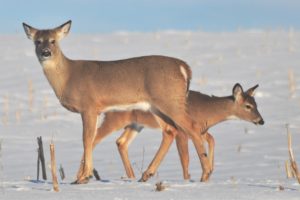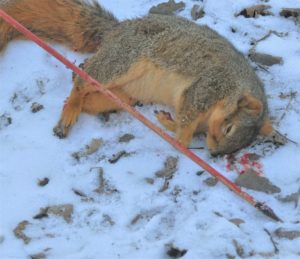Photography courtesy of Lowell Washburn, all rights reserved.
Iowa’s late muzzleloader deer season is one of my favorite hunts. In addition to black powder rifles, bow and arrow are also allowed during the season’s final segment; making the late season a great prospect for taking a bonus archery deer.
By the time January arrives, the Iowa landscape is locked in the dead of winter. Frigid, often below zero, temperatures and substantial snow cover blanket the landscape. The harsh conditions quickly put wintering deer into more or less predictable patterns as herds key on food sources and move along well-established snow trails. Although the season is not without challenge, success can still be achieved.
It should be noted that all of the above descriptions only apply to “normal” January deer seasons. This year has been anything but normal. When snow cover arrived during late November and early December, hunters naturally assumed that the snow would get deeper, the weather colder, and the hunting better. Didn’t happen. Instead, snow cover rapidly dissolved as early January temperatures soared into the 40s and beyond. For resident white-tails, the unexpected warm up was a signal to abandon traditional winter woodlands to bask on the side of sundrenched terraces, open wetland edge, and grassy fencelines. Locating high quality food sources became a nonissue and deer returned to their largely nocturnal lifestyles. The result has been one of the worst late muzzleloader seasons and poorest deer harvests in recent memory; at least that’s the case on the public and private areas where I hunt as well as for most of the other hunters I talk to.
In all fairness, my lack of January success cannot be entirely blamed on the weather. After seeing few deer and then whiffing the only shot I had at a post shotgun season buck, I finally traded the longbow for a .58 caliber cap lock muzzleloader. While hunting from the ground inside a thick stand of saplings, a sleek young buck suddenly pranced into view during my first hunt. My current supply of venison – even with diligent rationing — will likely be depleted before winter’s end. Considering the need, I quickly decided to add the buck to my dwindling inventory. The deer continued its approach until finally stopping at a distance of around 15 paces. Slowly raising the muzzleloader’s heavy octagon barrel, I concentrated on lining up the sights and dropped the hammer. The .58 roared, instantly obscuring my vision in a dense cloud of billowing white smoke. When the smoke cleared, I was astonished to see that the buck was not only still on its feet but was sprinting for the far horizon like a turbo charged greyhound.
I was a mite confused. Although I’m not a great rifle shot, I don’t generally miss something the size of a stationary deer standing at 15 yards or less. Staring into the saplings where the buck had stood, I quickly spotted a clue – a three-inch diameter tree with a noticeable white buckle in its trunk. Walking to the sapling, the mystery was solved. While intently focusing my rifle sights on the deer’s rib cage, I had completely blurred the tree out my vision – similar to what happens when a telephoto camera lens focuses out all the insignificant objects that lay between its glass eye and the main subject. The consequence in this case was that the rifle’s round ball had dead centered the sapling which was nearly cut in half by the impact. The unintended collision had not only sapped the projectile’s energy but had also caused the lead ball to veer sharply off course; probably missing the deer’s shoulder by only an inch or two – maybe less.
Putting the rifle back on the rack, I returned to carrying the longbow and spotted a nice buck a couple of hunts later. Unfortunately, the deer was traveling on an out of range trail. I tried calling. The buck became curious but failed to commit. The closest he came to my stand was about 30 yards or so. If I’d have still been carrying the rifle – Well, who knows?
On a more positive note, I couldn’t help noticing that the woods were alive with plump and colorful, orange bellied fox squirrels. When one hopped to within ten or twelve paces, I decided to give it a try. Loading the lightweight broadhead I carry for just such occasions, I drew the bow and released the string. The fat bushy tail jumped and then lay still, coming to rest in a shaded spot just a couple of inches from one of the last deer tracks remaining in the woodland’s rapidly disappearing snow.
Although the squirrel was not exactly what I’d hoped for, things could have been worse. Squirrels are delicious. Baked or fried, I enjoy eating fox squirrels almost as much as I love fresh venison. The way things are shaping up, that fat two-pound, 5-ounce squirrel may be the only ‘buck’ I manage to take from this year’s January woodland. Any way you slice it, the end of the late deer season is looming near. But no matter how carefully we try to ration the meat, a single fox squirrel never seems to go as far as a white-tailed deer.




 Tom Cope
Tom Cope Sue Wilkinson
Sue Wilkinson Susan Judkins Josten
Susan Judkins Josten Rudi Roeslein
Rudi Roeslein Elyssa McFarland
Elyssa McFarland Mark Langgin
Mark Langgin Adam Janke
Adam Janke Joe Henry
Joe Henry Kristin Ashenbrenner
Kristin Ashenbrenner Joe Wilkinson
Joe Wilkinson Dr. Tammy Mildenstein
Dr. Tammy Mildenstein Sean McMahon
Sean McMahon